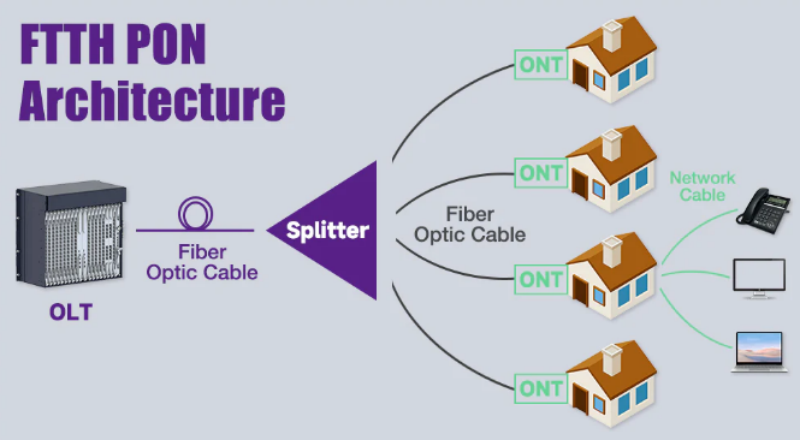As the continuous demand for faster, more reliable internet continues to mushroom, Fiber-to-the-Home (FTTH) is now the foundation of modern digital life. With unbeatable speed and reliability, FTTH fuels everything from buffer less 4K streaming to home automation. But bringing this tech to mass markets is fraught with very real issues - most significantly, high infrastructure costs, complicated installations, and bureaucratic slowdowns. Even with these challenges, businesses such as Oyi International, Ltd. are spearheading the FTTH charge with state-of-the-art, cost-effective fiber optic technologies. By enhancing availability and simplifying rollout complexity, they're making global communities' access to high-bandwidth networks upon which the digital economy depends possible.

The FTTH Revolution: Faster, Smarter, Stronger
FTTH connects fiber optic communications signals directly from an Internet Service Provider to the customer site, in contrast to slower signal-attracting copper wires. The greatest advantage of FTTH is that it has the ability to offer symmetrical upload and download speeds, low latency, and greater long-term reliability.
As more and more consumers expect 4K streaming, smart home connectivity, distance learning, and work-from-home functionality, FTTH is no longer a luxury but very much a necessity. Demand around the world for the technology is accelerating with companies like Oyi International, Ltd. at the forefront by providing stable, cost-effective fiber optic services to 143 countries.
Important FTTH Deployment Components
Effective FTTH deployment consists of a number of items, some of which include distribution fiber cables, installments, and connectors. One of these items is the aerial drop cable. The aerial drop cable links the main distribution point to the premises of subscribers along utility poles directly into homes. The aerial drop cable has to be weather-resistant, durable, and lightweight in order to withstand extreme environmental conditions
Oyi offers premium non-metallic drop cables like the GYFXTY model, which are particularly ideal for both aerial and duct installations. The cables are cost-effective, easy to install, and offer high transmission capacity - features that make them ideal for last-mile FTTH applications.

Challenges Hindering FTTH Growth
Despite the immense potential for FTTH, its widespread adoption is being held back by a series of challenges:
1. High Initial Investment
Fiber optic infrastructure installation demands enormous initial expenses. The process of trenching, cable burial, and terminal installation is very labor-intensive and typically costly. This becomes a problem, especially in rural or developing regions with low population concentrations.
2. Logistical and Regulatory Challenges
The process of getting permits to install fiber on public or private lands can hold up projects. In certain regions, outmoded laws or coordination problems among the utility companies create problems.
3. Lack of Skilled Labor
Installation of fiber optics demands special training, from cable splicing to terminal equipment configuration. Trained technocrats are in short supply in most of the planet, further deterring rollout.
Drop Line Innovations to the Rescue
To overcome these challenges, new products such as the cable drop line are now entering the scene. A cable drop line is an easy-to-operate pre-connected cable that can be easily installed and maintained. Such lines minimize the cost and time needed to connect houses, and FTTH becomes viable even under adverse conditions.
OYI's drop line solutions, for example, integrate rugged design with plug-and-play features, allowing for faster connections and reduced labor costs. Combined with their customized OEM options and financial support programs, OYI is helping partners expand FTTH networks with lower risk and greater efficiency.

The Future of FTTH: Opportunities and Outlook
The international thrust towards digitalization is compelling governments and private players to spend big time on FTTH infrastructure. In nations such as China, South Korea, and Sweden, FTTH penetration has already crossed 70%. As the emerging economies start to catch up with the vision of fiber networks, the pace of adoption will increase exponentially in Africa, Southeast Asia, and Latin America.
New technologies for constructing fiber cable, such as foldable and micro-duct designs, are cutting installation time and expense. Smart cities and the Internet of Things (IoT) are generating new demand for high-bandwidth, low-latency links that only FTTH can supply, in the meantime.
Fiber-to-the-Home isn't just a technology innovation - it's a disruptive network connecting communities, stimulating economic growth, and bridging the digital gap. While cost, regulation, and skilled personnel remain challenges, product improvements like the aerial drop cable and cable drop line are fueling global adoption.
With visionary producers such as Oyi International, Ltd. at the forefront, FTTH is becoming more and more available and viable. As we journey deeper into the digital era, the mass popularization of FTTH will be at the center of making a quicker, wiser, and more interconnected future possible.

 0755-23179541
0755-23179541  sales@oyii.net
sales@oyii.net
